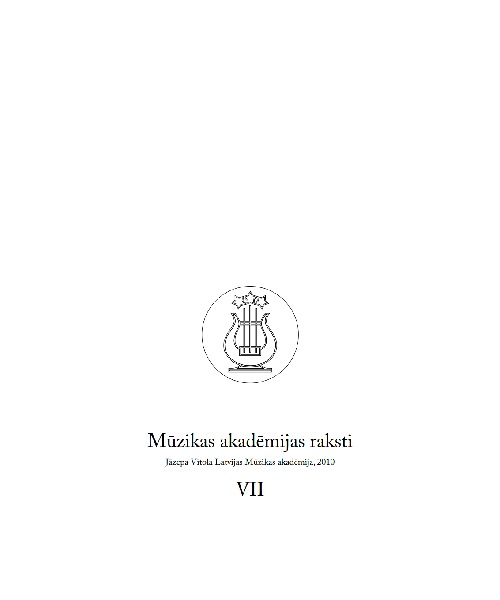MAX KLINGER, JOHANNES BRAHMS AND THE PROMISE OF THE GESAMTKUNSTWERK: REVISITING KLINGER’S BRAHMS-PHANTASIE (1894)
Keywords:
Max Klinger, Johannes Brahms, Brahms-Phantasie, Richard Wagner, multimedia, collaborative art workAbstract
Max Klinger’s Brahms-Phantasie (1894), a volume consisting of fortyone drawings and etchings interspersed with the complete scores of six of Brahms’s vocal works, cemented Klinger’s reputation as the most original artist that Germany has the honor of calling her own (Boetzkes, 1984 : 96), as Hugo von Hofmannstahl declared. In producing the volume, Klinger sought to cast a glance across the range of feeling that he encountered in Brahms’s music, and from there, to sympathize and to go further, to connect and to expand (Kersten, 1993 : 166). By 1894, Klinger had achieved considerable renown as a visual artist. But the Brahms-Phantasie was something more than just another volume of the artist’s famous prints. It was a work to be seen and heard, either literally (when Brahms’s scores are performed) or in the mind of the observer. As such, it exemplified the new, composite art form that Klinger described as Raumkunst or Spatial Art (Klinger, 1987 : 30). Inspired by Richard Wagner’s theory of the Gesamtkunstwerk, Klinger envisioned the Raumkunstwerk as an integral union of artistic media, literally filling the Raum or space inhabited by the observer.
Downloads
References
Abrams, Meyer H. The Mirror and the Lamp: Romantic Theory and the Critical Tradition. New York: Oxford University Press, 1953
Bahr, Hermann. Renaissance. Neue Studien zur Kritik der Moderne. Berlin: S. Fischer, 1897
Berry, Paul. Old Love: Johannes Brahms, Clara Schumann, and the Poetics of Musical Memory. Journal of Musicology 24/1 (2007), 72–111
Bisanz-Prakken, Marian. Gustav Klimt: Der Beethovenfries. Geschichte, Funktion und Bedeutung. Salzburg: Residenz, 1977
Boetzkes, Manfred (Hrsg.). Max Klinger. Wege zum Gesamtkunstwerk. Mainz am Rhein: Philipp von Zabern, 1984
Bonds, Mark Evan. After Beethoven: Imperatives of Originality in the Symphony. Cambridge and London: Harvard University Press, 1996
Botstein, Leon. Brahms and Nineteenth-Century Painting. 19th-Century Music 14/2 (1990), 154–168
Bouillon, Jean-Paul. Klimt: Beethoven / Translated by Hanna Wulf. Tübingen: Ernst Wasmuth, 1988
Brachmann, Jan. „Ins Ungewisse hinauf . . .” Johannes Brahms und Max Klinger im Zwiespalt von Kunst und Kommunikation. Kassel: Bärenreiter, 1999
Braemer, Edith. Goethes Prometheus und die Grundpositionen des Sturm und Drang. Weimar: Arion, 1963
Brodbeck, David. Brahms, the Third Symphony, and the New German School. In: Frisch, Walter, and Kevin C. Karnes (eds). Brahms and His World. Princeton: Princeton University Press, 2009, 95–116
Celenza, Anna Harwell. Music and the Viennese Secession: 1897–1902. Music in Art XXIX/1–2 (2004), 203–212
Chafe, Eric. The Tragic and the Ecstatic: The Musical Revolution of Wagner’s Tristan and Isolde. Oxford and New York: Oxford University Press, 2005
Comini, Alessandra. The Changing Image of Beethoven: A Study in Mythmaking. New York: Rizzoli, 1987
Daly, Peter M. Literature in the Light of the Emblem: Structural Parallels between the Emblem and Literature in the Sixteenth and Seventeenth Centuries. Toronto: University of Toronto Press, 1998
Daverio, John. The „Wechsel der Töne” in Brahms’s „Schicksalslied”. Journal of the American Musicological Society 46/1 (1993), 84–113
Frisch, Walter. German Modernism: Music and the Arts. Berkeley and Los Angeles: University of California Press, 2005
Frisch, Walter, and Kevin C. Karnes (eds). Brahms and His World. Princeton: Princeton University Press, 2009
Gleisberg, Dieter (Hrsg.). Max Klinger 1857–1920. Leipzig: Edition Leipzig, 1992
Goethe, Johann Wolfgang von. Sämtliche Werke nach Epochen seines Schaffens / 21 Bde. Hrsg. von Karl Richter. München: Carl Hanser, 1985–1998
Grey, Thomas S. Wagner the Degenerate: Fin de Siècle Cultural „Pathology” and the Anxiety of Modernism. Nineteenth Century Studies 16 (2002), 73–92
[Hake, Alfred Egmont]. Regeneration: A Reply to Max Nordau / With Introduction by Nicholas Murray Butler. New York: G. P. Putnam’s Sons; London: Archibald Constable & Co., 1896
Hanslick, Eduard. Discovering Brahms (1862–72) / Translated by Kevin C. Karnes. In: Frisch, Walter, and Kevin C. Karnes (eds). Brahms and His World. Princeton: Princeton University Press, 2009, 217–231
Harper, Anthony J., and Ingrid Höpel (eds.). The German-Language Emblem in its European Context: Exchange and Transmission. Glasgow: Glasgow University Library, 2000
Heimerl, Joachim. Systole und Diastole. Studien zur Bedeutung des Prometheussymbols im Werk Goethes. München: Iudicium, 2001
Janik, Allan. Wittgenstein’s Vienna Revisited. New Brunswick: Transaction Publishers, 2001
Johannes Brahms an Max Klinger. Leipzig: Gesellschaft der Musikfreunde, 1924
John, Barbara. Max Klinger: Beethoven. Leipzig, E. A. Seemann, 2004
Kalbeck, Max. Johannes Brahms / 4 Bde. Berlin: Deutsche BrahmsGesellschaft, 1912–1921
Kersten, Ursula. Max Klinger und die Musik. Frankfurt am Main: Verlag Peter Lang, 1993
Klinger, Max. Brahms-Phantasie. Einundvierzig Stiche, Radierungen und Steinzeichnungen zu Compositionen von Johannes Brahms. Berlin: Amsler und Ruthardt, 1894
Klinger, Max. Malerei und Zeichnung. Tagebuchaufzeichnungen und Briefe / Hrsg. von Anneliese Hübscher. Leipzig: Reclam, 1987
Lipiner, Siegfried. Über die Elemente einer Erneuerung religiöser Ideen in der Gegenwart. Vortrag gehalten im Lesevereine der deutschen Studenten Wiens am 19. Januar 1878. Vienna: Selbstverlag des Vorstandes des Lesevereines der deutschen Studenten Wiens, 1878
Magee, Bryan. Aspects of Wagner. Oxford and New York: Oxford University Press, 1988
Magee, Bryan. The Tristan Chord: Wagner and Philosophy. New York: Henry Holt, 2000
Max Klinger: Die druckgraphischen Folgen. Heidelberg: Braus, 2007
Mayer-Pasinski, Karin. Max Klingers Brahmsphantasie. Frankfurt am Main: Rita G. Fischer, 1982
Morton, Marsha. „Malerei und Zeichnung”: The History and Context of Max Klinger’s Guide to the Arts. Zeitschrift für Kunstgeschichte 58/4 (1995), 542–569
Nietzsche, Friedrich. Unpublished Writings from the Period of „Unfashionable Observations” / Edited and translated by Richard T. Gray. Stanford: Stanford University Press, 1995
Nordau, Max Simon. Degeneration. New York: D. Appleton & Co., 1895
Russell, Daniel S. The Emblem and Device in France. Lexington: French Forum, 1985
Scruton, Roger. Death-Devoted Heart: Sex and the Sacred in Wagner’s Tristan and Isolde. Oxford and New York: Oxford University Press, 2004
Singer, Hans Wolfgang. Max Klingers Radierungen, Stiche und Steindrucke. Wissenschaftliches Verzeichnis. Berlin: Amsler und Ruthardt, 1909
Solie, Ruth A. Music in Other Words: Victorian Conversations. Berkeley, Los Angeles and London: University of California Press, 2004
Streicher, Elizabeth Pendleton. Max Klinger’s Malerei und Zeichnung: The Critical Reception of the Prints and Their Text. Studies in the History of Art 53 (1996), 228–249
Taruskin, Richard. The Oxford History of Western Music / 6 Vols. Oxford and New York: Oxford University Press, 2005
Varnedoe, J. Kirk T., and Elizabeth Streicher. Graphic Works of Max Klinger. New York: Dover, 1977
Wagner, Richard. Sämtliche Schriften und Dichtungen. Volksausgabe / 16 Bde. Leipzig: Breitkopf und Härtel, 1911–1914
Walzel, Oskar Franz. Das Prometheussymbol von Shaftesbury zu Goethe. Leipzig und Berlin: Teubner, 1910
Warlick, Max Ernst. Art, Allegory and Alchemy in Peter Greenaway’s Prospero’s Books. In: Wygant, Amy (ed.). New Directions in Emblem Studies / Glasgow Emblem Studies, 4. Glasgow: Glasgow Emblem Studies, 1999, 109–136
West, Shearer. Fin de Siècle: Art and Society in an Age of Uncertainty. Woodstock, New York: Overlook Press, 1994



